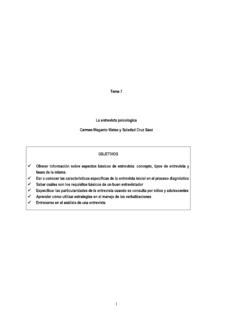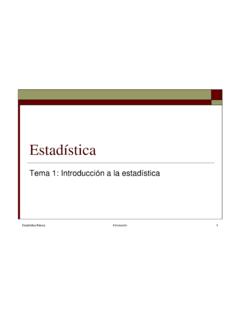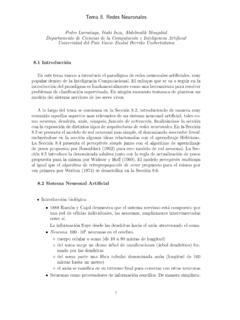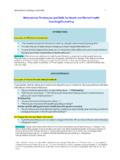Transcription of Solving the 0-1 Knapsack Problem with ... - Gipuzkoako …
1 Solving the 0-1 Knapsack Problem with Genetic AlgorithmsMaya HristakevaComputer Science DepartmentSimpson ShresthaComputer Science Department Simpson College This paper describes a research project on using Genetic Algorithms (GAs) to solve the0-1 Knapsack Problem (KP). The Knapsack Problem is an example of a combinatorialoptimization Problem , which seeks to maximize the benefit of objects in a knapsackwithout exceeding its capacity. The paper contains three sections: brief description of the basic idea and elements of theGAs, definition of the Knapsack Problem , and implementation of the 0-1 KnapsackProblem using GAs. The main focus of the paper is on the implementation of thealgorithm for Solving the Problem . In the program, we implemented two selectionfunctions, roulette-wheel and group selection. The results from both of them differeddepending on whether we used elitism or not. Elitism significantly improved theperformance of the roulette-wheel function.
2 Moreover, we tested the program withdifferent crossover ratios and single and double crossover points but the results givenwere not that different. IntroductionIn this project we use Genetic Algorithms to solve the 0-1 Knapsack Problem where onehas to maximize the benefit of objects in a Knapsack without exceeding its the Knapsack Problem is a NP Problem , approaches such as dynamic programming,backtracking, branch and bound, etc. are not very useful for Solving it. GeneticAlgorithms definitely rule them all and prove to be the best approach in obtainingsolutions to problems traditionally thought of as computationally infeasible such as theKnapsack Algorithms (GAs)Genetic Algorithms are computer algorithms that search for good solutions to a problemfrom among a large number of possible solutions. They were proposed and developed inthe 1960s by John Holland, his students, and his colleagues at the University ofMichigan. These computational paradigms were inspired by the mechanics of naturalevolution, including survival of the fittest, reproduction, and mutation.
3 These mechanicsare well suited to resolve a variety of practical problems, including computationalproblems, in many fields. Some applications of GAs are optimization, automaticprogramming, machine learning, economics, immune systems, population genetic, andsocial idea behind GAsGAs begin with a set of candidate solutions (chromosomes) called population. A newpopulation is created from solutions of an old population in hope of getting a betterpopulation. Solutions which are chosen to form new solutions (offspring) are selectedaccording to their fitness. The more suitable the solutions are the bigger chances theyhave to reproduce. This process is repeated until some condition is satisfied [1].Basic elements of GAsMost GAs methods are based on the following elements, populations of chromosomes,selection according to fitness, crossover to produce new offspring, and random mutationof new offspring [2]. Chromosomes The chromosomes in GAs represent the space of candidate solutions.
4 Possiblechromosomes encodings are binary, permutation, value, and tree encodings. For theKnapsack Problem , we use binary encoding, where every chromosome is a string of bits,0 or functionGAs require a fitness function which allocates a score to each chromosome in the currentpopulation. Thus, it can calculate how well the solutions are coded and how well theysolve the Problem [2].SelectionThe selection process is based on fitness. Chromosomes that are evaluated with highervalues (fitter) will most likely be selected to reproduce, whereas, those with low valueswill be discarded. The fittest chromosomes may be selected several times, however, thenumber of chromosomes selected to reproduce is equal to the population size, therefore,keeping the size constant for every generation. This phase has an element of randomnessjust like the survival of organisms in nature. The most used selection methods, areroulette-wheel, rank selection, steady-state selection, and some others.
5 Moreover, toincrease the performance of GAs, the selection methods are enhanced by eiltism. Elitismis a method, which first copies a few of the top scored chromosomes to the newpopulation and then continues generating the rest of the population. Thus, it preventsloosing the few best found solutions. CrossoverCrossover is the process of combining the bits of one chromosome with those of is to create an offspring for the next generation that inherits traits of both randomly chooses a locus and exchanges the subsequences before and afterthat locus between two chromosomes to create two offspring [2]. For example, considerthe following parents and a crossover point at position 3:Parent 1 1 0 0 | 0 1 1 1 Parent 21 1 1 | 1 0 0 0 Offspring 1 1 0 0 1 0 0 0 Offspring 21 1 1 0 1 1 1In this example, Offspring 1 inherits bits in position 1, 2, and 3 from the left side of thecrossover point from Parent 1 and the rest from the right side of the crossover point fromParent 2.
6 Similarly, Offspring 2 inherits bits in position 1, 2, and 3 from the left side ofParent 2 and the rest from the right side of Parent 1. MutationMutation is performed after crossover to prevent falling all solutions in the populationinto a local optimum of solved Problem . Mutation changes the new offspring by flippingbits from 1 to 0 or from 0 to 1. Mutation can occur at each bit position in the string withsome probability, usually very small ( ). For example, consider the followingchromosome with mutation point at position 2: Not mutated chromosome: 1 0 0 0 1 1 1 Mutated:1 1 0 0 1 1 1 The 0 at position 2 flips to 1 after mutation. Outline of basic GA s1. Start: Randomly generate a population of N chromosomes. 2. Fitness: Calculate the fitness of all Create a new population:a. Selection: According to the selection method select 2 chromosomesfrom the population. b. Crossover: Perform crossover on the 2 chromosomes selected. c. Mutation: Perform mutation on the chromosomes Replace: Replace the current population with the new population.
7 5. Test: Test whether the end condition is satisfied. If so, stop. If not, return thebest solution in current population and go to Step 2. Each iteration of this process is called generation. The Knapsack Problem (KP)Definition The KP Problem is an example of a combinatorial optimization Problem , which seeks fora best solution from among many other solutions. It is concerned with a Knapsack that haspositive integer volume (or capacity) V. There are n distinct items that may potentially beplaced in the Knapsack . Item i has a positive integer volume Vi and positive integerbenefit Bi. In addition, there are Qi copies of item i available, where quantity Qi is apositive integer satisfying 1 Qi . Let Xi determines how many copies of item i are to be placed into the Knapsack . The goalis to: Maximize N Bi Xi i = 1 Subject to the constraints N Vi Xi V i = 1 And 0 Xi one or more of the Qi is infinite, the KP is unbounded; otherwise, the KP is bounded[3].
8 The bounded KP can be either 0-1 KP or Multiconstraint KP. If Qi = 1 for i = 1, 2,.., N, the Problem is a 0-1 Knapsack Problem In the current paper, we have worked onthe bounded 0-1 KP, where we cannot have more than one copy of an item in theknapsack. Example of a 0-1 KPSuppose we have a Knapsack that has a capacity of 13 cubic inches and several items ofdifferent sizes and different benefits. We want to include in the Knapsack only these itemsthat will have the greatest total benefit within the constraint of the Knapsack s are three potential items (labeled A, B, C ). Their volumes and benefits are asfollows:Item #ABCB enefit 435 Volume 678We seek to maximize the total benefit: 3 Bi Xi = 4X1 + 3X2 + 5X3 i = 1 Subject to the constraints: 3 Vi Xi = 6X1 + 7X2 + 8X3 13 i = 1 AndXi {0,1}, for i= 1, 2, .., n. For this Problem there are 23 possible subsets of items: ABCV olume of the setBenefit of the set 00000001850107301115-1006410114-11013711 121-In order to find the best solution we have to identify a subset that meets the constraint andhas the maximum total benefit.
9 In our case, only rows given in italics satisfy theconstraint. Hence, the optimal benefit for the given constraint (V = 13) can only beobtained with one quantity of A, one quantity of B, and zero quantity of C, and it is 7. NP problems and the 0-1 KP NP (non-deterministic polynomial) problems are ones for which there are no knownalgorithms that would guarantee to run in a polynomial time. However, it is possible to guess a solution and check it, both in polynomial time. Some of the most well-knownNP problems are the traveling salesman, Hamilton circuit, bin packing, Knapsack , andclique [4]. GAs have shown to be well suited for high-quality solutions to larger NP problems andcurrently they are the most efficient ways for finding an approximately optimal solutionfor optimization problems. They do not involve extensive search algorithms and do nottry to find the best solution, but they simply generate a candidate for a solution, check inpolynomial time whether it is a solution or not and how good a solution it is.
10 GAs do notalways give the optimal solution, but a solution that is close enough to the optimal one. Implementation of the 0-1 KP Using GAs Representation of the itemsWe use a data structure, called cell, with two fields (benefit and volume) to representevery item. Then we use an array of type cell to store all items in it, which looks asfollows: items 01 2 3 20 | 305 | 1010 | 2040 | 50 Encoding of the chromosomesA chromosome can be represented in an array having size equal to the number of theitems (in our example of size 4). Each element from this array denotes whether an item isincluded in the Knapsack ( 1 ) or not ( 0 ). For example, the following chromosome: 0 1 2 31001indicates that the 1st and the 4th item are included in the Knapsack . To represent the wholepopulation of chromosomes we use a tri-dimensional array (chromosomes [Size][numberof items][2]). Size stands for the number of chromosomes in a population.









